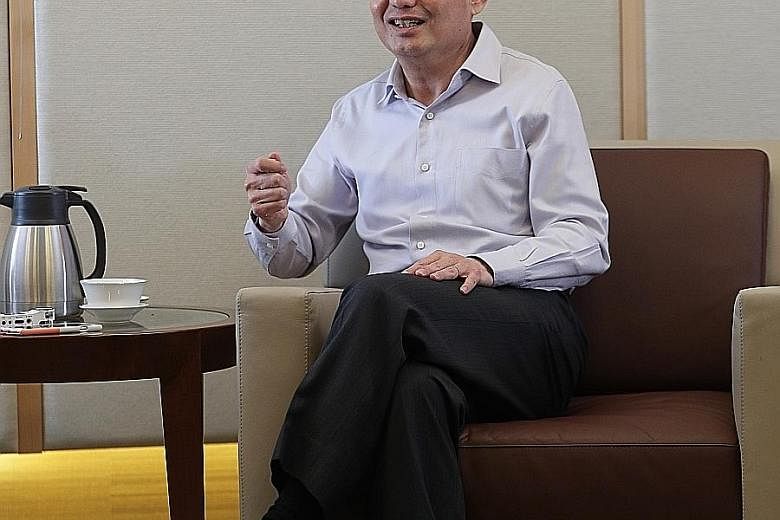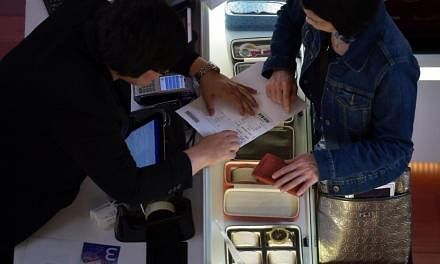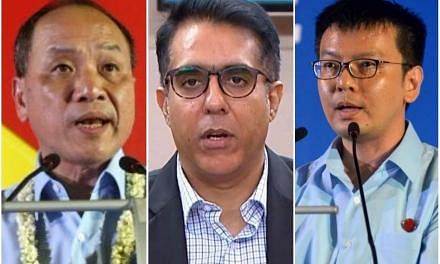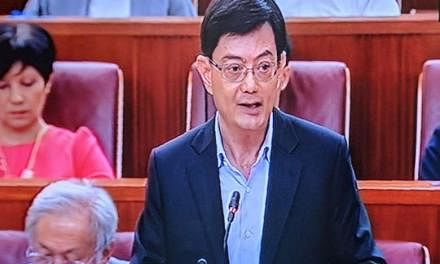Let me explain our approach to financing our needs.
There are essentially three ways of doing so: raise taxes; borrow; or draw on our reserves.
Each serves a purpose; each involves risks and trade-offs. We have decided on our approach only after deep and serious study.
Raising taxes
Let me first explain why we have decided to raise taxes. This is not an option that we have taken lightly. Not just because raising taxes is unpopular, but because the Government should as far as possible avoid taking people's hard-earned money and deciding on their behalf how the money should be spent, unless it has to do so for critical social, economic or national needs.
Certainly, we should not shy away from addressing the need for taxes, where we see areas of collective need that can be better met by government provision. These include areas like healthcare, supporting the elderly and retirees, investing in our people through pre-schools and SkillsFuture, and strengthening our security.
Looking ahead, we have needs that occur year after year. The responsible way for us to fund such spending is to raise taxes. As Dr Lee Bee Wah pithily reminded us, you don't fund recurrent spending needs by hoping to strike 4D. Or by borrowing with your credit card.

Each generation should strive to pay for its own spending through sustainable means, instead of drawing down more than is prudent from the reserves or by borrowing and passing on the cost of current spending to future generations.
In particular, for the broad-based needs, a broad-based tax like the goods and services tax (GST) is appropriate. Whenever we increase demands for public services, we should also pay more. Mr Lim Biow Chuan gave us a timely reminder that when the Government pays, it is the taxpayers who pay.
GST INCREASE: TIMING AND FAIRNESS
There have been questions on the timing of the GST increase that I have announced.
In planning our finances, we take the long view. We seek to understand major trends holistically, and how they may affect Singaporeans. We assess carefully what we need to do in response, and how we should find the resources to support our plans. This is how we had determined that we will need to raise GST some time in the period from 2021 to 2025.
By announcing the GST increase early, we are being honest and upfront about our national needs, and setting out what needs to be done. We are giving ample notice to citizens and businesses that we will need to raise GST.
I hope that it helps everyone to understand our shared challenges in the coming years. And indeed, we must have such important discussions about our future, well in advance.
This is important because it is not just government finances that will be impacted by trends like ageing, but individual citizens and their families. We must all prepare for what is to come. This will also help us to better determine an appropriate offset package that can help with the adjustment.
But we know that there are always uncertainties. That is why we have given a timeframe of 2021 to 2025 as to when this increase would need to take place.
Just as the decision to raise GST was not made lightly, the Government will exercise care in deciding the timing of its implementation. Before we move to raise the GST, we will carefully assess the prevailing economic conditions as well as our needs at that point.
HOW THE GST INCREASE IS SIZED
A 2 percentage point increase in the GST rate is expected to raise revenues worth about 0.7 per cent of GDP per annum. This estimated amount is before we account for the amount needed to fund the enhanced GST Voucher.
On the other hand, the expenditure drivers that I earlier mentioned - healthcare, security and pre-schools - already exceed this amount. These are serious commitments that we must budget for, and there are risks that overall spending could rise further.
So the 2 percentage point GST increase will not fully cover our expenditure needs, but only make the fiscal gap more manageable, in conjunction with other measures to manage expenditure. It is thus the prudent and responsible approach to raise GST in good time, instead of hoping for expenditure to fall.
Some are worried about the impact of a GST increase on the cost of living, not just among the lower income, but also among many middle-income households.
Let me assure everyone that we are mindful of the impact of tax changes on households, particularly the lower income, and will help them to adjust while maintaining a fair and progressive system of taxes and transfers.
The GST should be seen together with the rest of our taxes and transfers system, including the GST Voucher scheme.
For the lower income, we provide substantial offsets. For retiree households, they also get significant GST offsets. In addition, we have schemes and programmes to support the less well-off. From education to healthcare to housing, our social programmes provide higher levels of support for the lower-and middle-income households than they do for the well-off, with lower-income households benefiting the most.
When you look at the overall balance of taxes and transfers, lower-and middle-income households receive significantly more benefits from transfers than what they pay in taxes. The middle-income group gets $2 in benefits for every dollar of tax that they pay. The lower-income group gets about $4 in benefits for every dollar of tax.
When we eventually raise the GST, we will enhance the permanent GST Voucher scheme to provide more help to lower-income households and seniors. We will also implement a transitional offset package, with lower-and middle-income households receiving more support, to help them adjust.
WEALTH TAX
Some members have asked if we are doing enough to tax wealth, and if those with higher income are contributing a fair share. Dr Intan Azura Mokhtar has suggested raising personal income taxes (PIT).
We have raised personal income taxes in recent years to further enhance progressivity. We increased the marginal tax rates for higher-income earners with chargeable income exceeding $160,000, and raised the top marginal rate from 20 to 22 per cent for those with chargeable income exceeding $320,000. This took effect from YA2017.
We also introduced a cap of $80,000 on personal income tax reliefs, taking effect from YA2018.
Under the present PIT structure, about half of our workers do not pay personal income tax. Among those who do, the top 10 per cent pay about 80 per cent of our personal income tax revenue.
Any review of personal income taxes must ensure that Singapore remains attractive. Hong Kong has announced a reduction in personal income taxes in their Budget. We will be moving in the opposite direction if we are to raise personal income taxes when all jurisdictions are competing for talent, including our Singaporean talent.
We will continue to monitor and review our rates, but for now, our view is that existing PIT rates are reasonable for us to remain attractive given the intense global competition for talent.
Mr Ong Teng Koon and Mr Yee Chia Hsing suggested that we look closely at wealth taxes.
Aside from taxing income, our current approach to taxing wealth is mainly through taxes on assets that cannot be tax-planned away easily, unlike other methods like estate duties.
That is why we have enhanced our property tax regime in the last decade to make it more progressive, and to meet our spending needs. For residential properties, 86 per cent of property tax collected comes from non-owner-occupied residential properties, and owner-occupied residential properties with annual value of $30,000 and above.
In this Budget, we have made moves to improve the progressivity of our stamp duty regime, so that those who can afford a higher-value residential property pay more taxes on their purchase. On average, we collected about $8 billion in recent years from property tax and stamp duty. This is a significant proportion of our revenues. We will continue to review this area closely.
CORPORATE INCOME TAX
Let me talk about keeping our fiscal system pro-growth.
Dr Intan has raised suggestions to raise corporate income tax rates, particularly for MNCs and large firms.
Around the world, there are significant changes and uncertainties in the global tax environment. There is ongoing discussion worldwide on international tax rules for combating tax avoidance under the base erosion and profit shifting (BEPS) project.
In 2018, the US reduced its headline corporate income tax rate from 35 per cent to 21 per cent. It also made other changes to make it more attractive for US companies to invest at home. This may spur cuts in corporate income tax rates around the world.
Singapore must remain sensitive to these global trends that impact us. We are a small and open economy, subject to the full forces of competition in a globalised economy.
It is important for us to remain a competitive and business-friendly location. In 2017, $9.4 billion of fixed asset investments and $6.5 billion of total business expenditure were committed. When the projects are fully implemented, about 22,500 jobs will be created.
The increase in the GST is not expected to impact our competitiveness significantly. The future GST rate of 9 per cent is not high by international standards. The OECD average is 19 per cent. Among countries in the region, many others have GST standard rates that exceed 9 per cent. Some countries are also contemplating raising GST. Japan, for example, plans to raise its consumption tax rate from 8 per cent to 10 per cent in October 2019.
Borrowing for long-term investments
Borrowing is a reasonable option for long-lived capital investments with high capital expenses, because the benefits of these assets are enjoyed mainly by future generations many years down the road. This is an option that we are pursuing for major long-term projects like Changi Terminal 5.
Ms Tin Pei Ling and Mr Saktiandi Supaat raised concerns on whether borrowing will result in unsustainable debt and interest payments. They have raised an important point: Indeed, we aim to live within our means. We should not over-borrow and burden future generations with unsustainable debt, as we have seen in other countries.
The stark difference is that unlike some other countries, we borrow not to spend on recurrent needs like healthcare, education and security, but to invest in long-term infrastructure. Such long-term investments will continue to yield economic benefits and position Singapore well for the future.
We are strategically leveraging the strength of our financial position to optimise our borrowing.
To reduce financing costs, the Government is considering the provision of guarantees to back borrowings by our statutory boards and government-owned companies.
The Government is consulting the President's Office and the Council of Presidential Advisers on this proposal, including the details of how it will be structured.
This way, we tap on the Government's triple-A credit rating and the strength of our reserves without directly using it. This is how we are helping the current and future generations.
We are able to do so only because we have planned our finances soundly and accumulated strong reserves. We are one of only 11 countries in the world, and the only Asian country, which has a triple-A credit rating, which represents the solid foundation and safety net that our forefathers left for us. We do not and cannot take our credit rating for granted.
Safeguarding reserves for future generations The third way we have been financing our needs is our reserves.
Our reserves have been painstakingly built up over half a century by our pioneers and previous generations. We have inherited this nest egg and must act as responsible stewards.
That is why over the years, we have carefully deliberated and developed a comprehensive set of rules to safeguard and manage the use of reserves. Our constitutional rules protect our financial assets and land as past reserves. As land sales convert physical assets into financial assets, the proceeds from land sales are rightly fully protected as past reserves as well.
This principle of asset conversion is sound. It is irresponsible to mislead people that the principle suddenly does not apply when we use 20 per cent instead of 100 per cent of land sale proceeds.
Mr Pritam Singh made such a suggestion. And if I may use an analogy: Suppose our forefathers left us five plots of land and each year we sell one plot, 20 per cent, and use that money. In five years, there will be no land left. So that is the fallacy of using 20 per cent.
Instead of using the proceeds of land sales, or any part of it, for spending, the proceeds of land sales are added to our reserves, which are invested in a globally diversified portfolio. From the returns, we take 50 per cent as NIRC (net investment return contributions) to supplement our budgetary needs. This achieves a balance between supporting the needs of the current and future generations.
Today, contributions from reserves are already the largest contributor to our revenues. If we did not introduce the NIR (net investment returns) framework, we would have had to double our personal income tax collection or our GST collection to raise the same amount of revenues.
Yet, some have suggested increasing the NIRC spending cap from the current 50 per cent to 60 per cent, or using a portion of land sale proceeds for recurrent social spending.
All these sound very tempting - it seems relatively painless to do so compared to raising taxes. And you may be wondering why I do not take a painless way. But is it the right thing to do? Certainly not.
The rules on reserves were debated and agreed in this House. We enshrined them in the Constitution. We deliberately introduced rules on land sales and the 50 per cent NIRC cap so that we do not succumb to the temptation to draw more from our reserves to fund current expenditure or eat into the principal sum.
To amend the rules as a first resort is ill-disciplined and unwise. This would defeat the purpose of enshrining the 50 per cent cap in our Constitution.
Moreover, if as soon as we need more money, the first thing we do is to relax the rules, that is the surest way to change Singapore's basic orientation - from saving and building for the future, to living for today and letting tomorrow look after itself.
We must not give in to the temptation to chip away at our strategic national asset. Indeed, we should not over-rely on NIRC, which is already the largest source of our revenues. An over-reliance will hurt our ability to respond to changing circumstances in the future.
We are stewards of the reserves for our future generations, as what our forefathers had been for us. It was thanks to the astute Dr Goh Keng Swee and other forefathers, who had the foresight of investing our reserves in a long-term and diversified portfolio early, that Singapore has built up a nest egg.
Since then, each generation of Singaporean leaders has upheld that discipline - of running balanced budgets, setting aside surpluses, having professional managers manage our reserves for long-term gain.
Today, the constitutional arrangements for the use of reserves represent this discipline we have set for ourselves.
Deviating from these rules in a sustained way will put this critical balance at risk, and may compromise the long-term health of our reserves and the country. Be it NIRC or land sale proceeds, we must uphold the discipline in tapping on our reserves in a sustainable way.
And to be clear, we prepare for the future not only within our own lifetime, but our children's and children's children.











